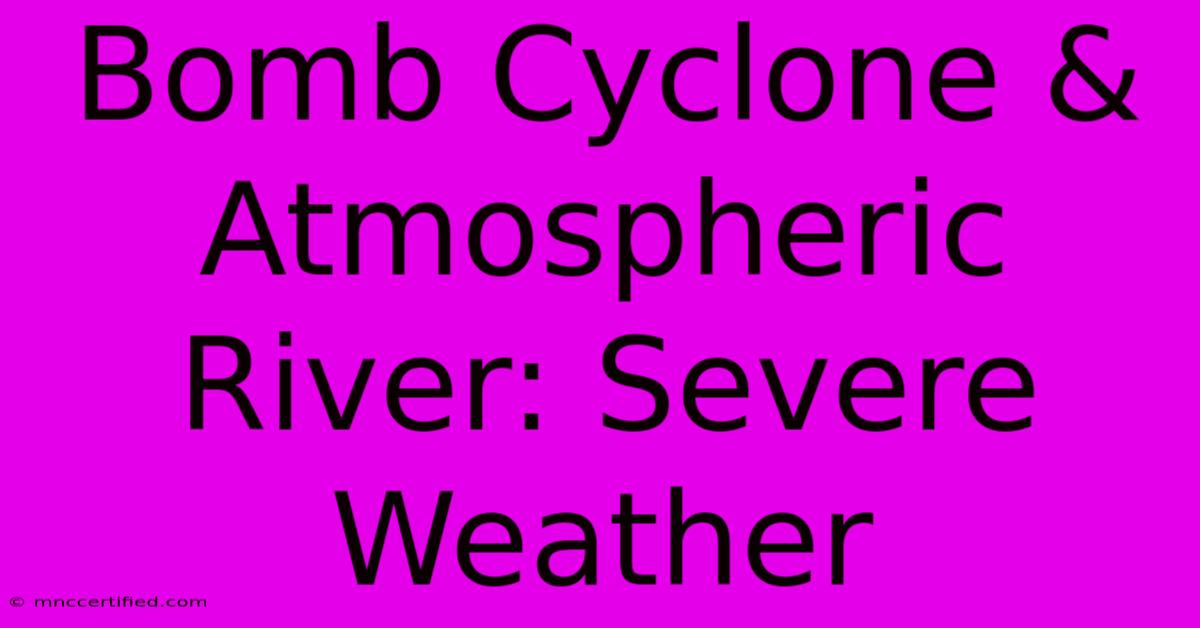Bomb Cyclone & Atmospheric River: Severe Weather

Table of Contents
Bomb Cyclone & Atmospheric River: Understanding Severe Weather Events
Bomb cyclones and atmospheric rivers are two powerful weather phenomena that can cause devastating consequences. Understanding their characteristics, differences, and the potential for combined impacts is crucial for preparedness and safety. This article delves into the specifics of each, explaining their formation, impacts, and how they relate to severe weather events.
What is a Bomb Cyclone?
A bomb cyclone, also known as a bombogenesis, is a mid-latitude cyclone that intensifies rapidly. This rapid intensification is defined by a drop in central pressure of at least 24 millibars in 24 hours. This process is called explosive cyclogenesis. The low pressure at the center of the storm creates a powerful pressure gradient, leading to strong winds spiraling inwards.
Formation of a Bomb Cyclone:
Bomb cyclones typically form when a cold air mass collides with a warm air mass over relatively warm ocean waters. The contrast in temperature and moisture fuels the storm's intensification. Specific atmospheric conditions, like the presence of a pre-existing weather system and upper-level atmospheric support, are also necessary for bombogenesis to occur.
Impacts of a Bomb Cyclone:
The devastating impacts of a bomb cyclone are multifaceted and include:
- High winds: Extremely strong winds can cause widespread damage to property, uproot trees, and knock down power lines.
- Heavy snowfall: Intense snowfall is common, especially in coastal areas, leading to blizzard conditions and significant disruptions to travel and daily life.
- Coastal flooding: Storm surge and high waves can cause severe coastal flooding, inundating low-lying areas and damaging infrastructure.
- Heavy rainfall: In warmer regions, bomb cyclones can produce torrential rainfall, leading to flash floods and mudslides.
What is an Atmospheric River?
An atmospheric river (AR) is a long, narrow, and transient corridor or filament of concentrated water vapor transport in the lower atmosphere. Think of it as a river in the sky. These rivers of moisture originate over tropical and subtropical oceans, carrying vast amounts of water vapor.
Formation of an Atmospheric River:
Atmospheric rivers form when strong winds transport large amounts of water vapor from tropical or subtropical regions towards higher latitudes. The moisture is often channeled along the western side of large-scale weather systems. The presence of sufficient atmospheric instability and lifting mechanisms is crucial for the formation of ARs.
Impacts of an Atmospheric River:
Atmospheric rivers, while capable of providing beneficial precipitation, can also cause significant problems when they deliver excessive moisture:
- Heavy rainfall and flooding: ARs can bring prolonged and exceptionally heavy rainfall, leading to widespread flooding, landslides, and mudslides.
- Snowpack impacts: In mountainous regions, ARs can contribute to significant snow accumulation, potentially increasing the risk of avalanches.
- Erosion and damage to infrastructure: The sheer volume of water delivered by ARs can cause significant erosion and damage to infrastructure, such as roads, bridges, and buildings.
Bomb Cyclones and Atmospheric Rivers: A Devastating Combination
The combination of a bomb cyclone and an atmospheric river can create an especially dangerous situation. The strong winds associated with the bomb cyclone can enhance the precipitation from the atmospheric river, leading to even more intense rainfall and snowfall. This combination amplifies the risks associated with each individual event, creating a significantly higher potential for severe flooding, high winds, and widespread damage.
Examples of combined events showcase the destructive potential. Researching historical instances helps illustrate the severity of the combined impact.
Preparing for Severe Weather Events
Regardless of whether it's a bomb cyclone, an atmospheric river, or a combination of both, preparedness is key:
- Stay informed: Monitor weather forecasts closely and heed warnings from local authorities.
- Develop an emergency plan: Have a plan for evacuation if necessary, and gather emergency supplies, including food, water, and medications.
- Protect your property: Secure loose objects, and consider steps to protect your home from flooding and wind damage.
By understanding the characteristics and potential impacts of bomb cyclones and atmospheric rivers, we can better prepare for and mitigate the devastating consequences of these severe weather events. Staying informed and taking proactive steps is crucial for ensuring safety and minimizing damage.

Thank you for visiting our website wich cover about Bomb Cyclone & Atmospheric River: Severe Weather. We hope the information provided has been useful to you. Feel free to contact us if you have any questions or need further assistance. See you next time and dont miss to bookmark.
Featured Posts
-
Estrella Insurance Wilton Manors
Nov 21, 2024
-
Public Reaction To Jaguars Rebrand
Nov 21, 2024
-
Nba Announcement Follows Westbrook Tech
Nov 21, 2024
-
Klinner Insurance Eagle River Wi
Nov 21, 2024
-
Brooks And Dunn Jelly Roll At 2024 Cma Awards
Nov 21, 2024